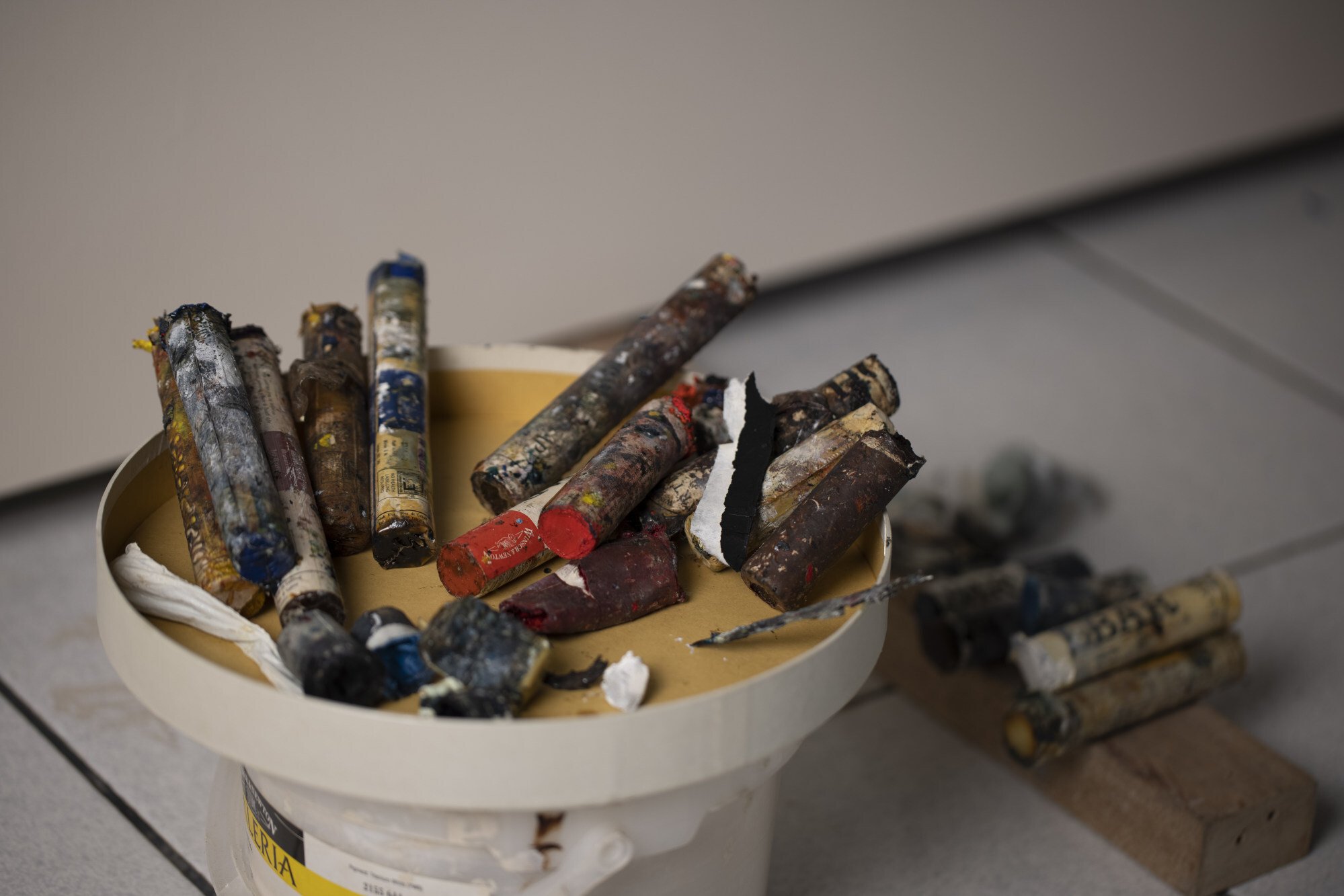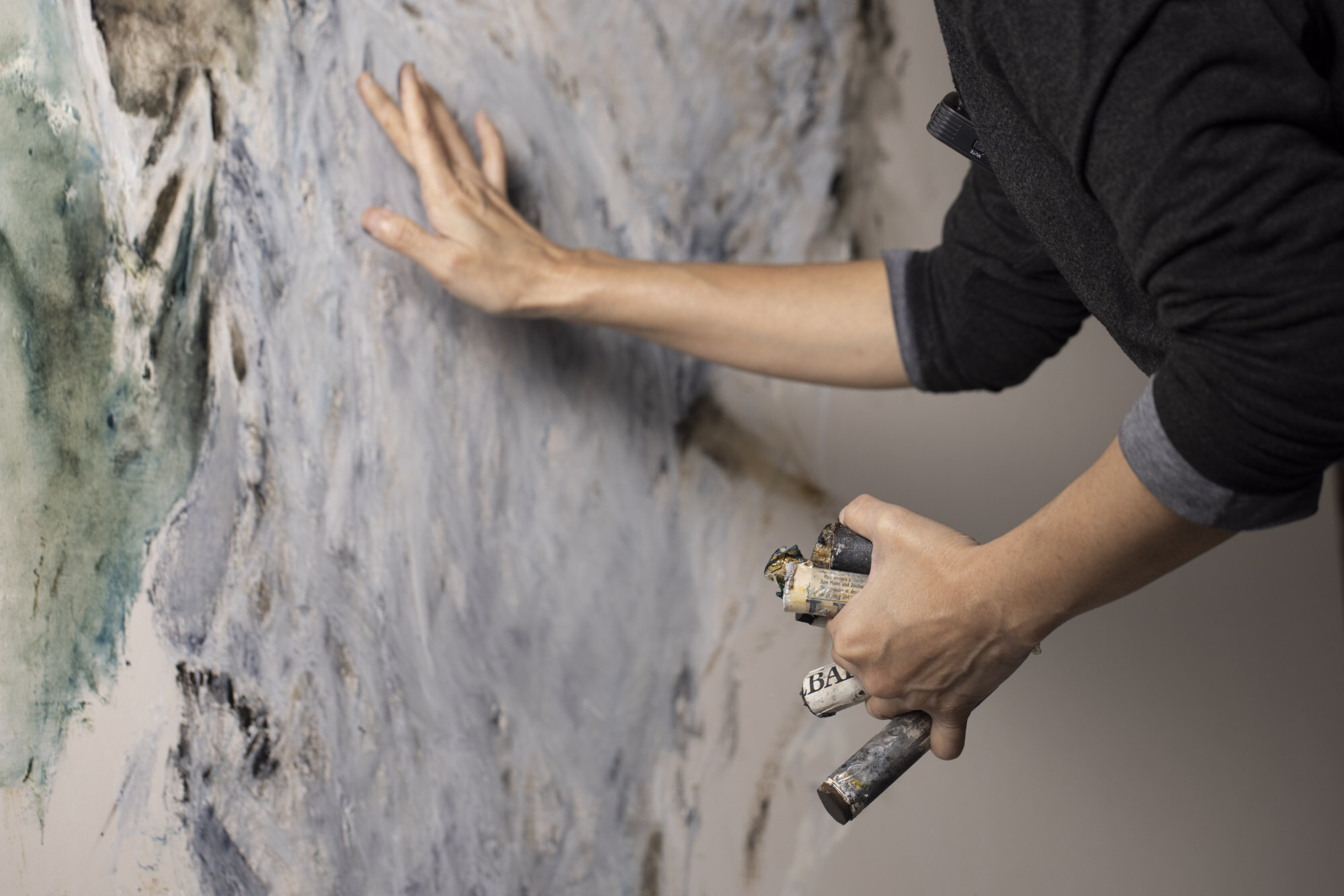
An artist’s response to coronavirus: Indonesian Christine Ay Tjoe imagines us dying a temporary death
- Christine Ay Tjoe often paints animalistic creatures, and it is animal behaviour that has inspired her new works depicting humans responding to the pandemic
- She talks about her creative process, the response to her gender and Chinese ethnicity, and why the rising prices paid for her art won’t affect her
Artist Christine Ay Tjoe grew up and continues to live and work in Bandung, in West Java, Indonesia. Born in 1973, she studied printmaking and graphic art at the Bandung Institute of Technology, the country’s top-ranking art school.
Best known for her large, oil-on-canvas paintings with gestural, ephemeral layers that are abstract but suggestive of manlike or animalistic creatures, she has also worked with fabric and dry point etching. She often draws with oil sticks and uses her hands to rub and smear the paint on the canvas. Regardless of the medium, drawing is at the heart of her practice.
Her first solo exhibition in Hong Kong, “Spinning in the Desert”, opens at White Cube, in Central on Hong Kong Island, on May 18.

The Hong Kong exhibition will show 12 new works representative of your pandemic experiences. How are they different from previous works?
“This exhibition will be quite different because it shows how I have responded to the challenging situation at the moment.
How does this state of suspension manifest itself in your new works?
“I have used colours that are calmer and dimmer than the ones I normally use, such as layers of whites and light blues. That is how I translate the sense of going deeper, to find a bigger space where we conduct our struggles. These paintings are predominantly blue because I consider blue to be the middle of the colour spectrum between white and black. It means there are stronger colours we can reach for, to aspire to, such as black and reds.”

Have your schedule and habits changed during the pandemic?
“We live in the northern part of Bandung. My house is high up on a plateau and surrounded by trees. There are birds and monkeys outside, and we keep a few cats. My studio is on the first floor and my family live on the second floor.
“I have an eight-year-old son and I am a single parent. Before the pandemic, I worked when he was at school. But my working hours have been sporadic since school went online. In normal times I worked every weekday in the studio and then took a couple of days off to refresh. I also used to travel several times a year. As a result, I think differently during this period.
“The government’s lockdown rules are not quite firm and people can go out as normal. But I have preferred to stay inside, apart from when I have urgent needs. I have been listening to electronic music that can build up the spirit while I work. I have also convinced myself that it is enough to visually visit places on the internet and have imaginary holidays.
“Maybe the way we lived before the pandemic was excessive and now we have an opportunity to create normal habits.”

Are there any symbols representing the pandemic in the paintings?
“I imagine the pandemic to be a long trip we are taking together, and we don’t know when this will be over. We need to try to get something beneficial out of it. Maybe before the pandemic we made so many mistakes, but we justified them. This is a moment when we can find something new. Some of the creatures in my art may be frightening and ambitious, and now they can be reminded to be human. I also depict how we fight. You can see layers of obstacles. They are repetitive. To change, we need repetition. So this symbolises something within us that wants to get out but we hold it back.”
Do you have to be in a certain frame of mind to work?
“I used to have a meditation routine but I don’t do it any more. Now, I find consciously practising certain daily routines can be meditative, and more practical. Everyone has their own spiritual side. To me, it is the same as understanding your own self and finding new values within. I usually spend two to three hours on a painting at a time.
“During the pandemic, I just start whenever I have the spare time. Whenever I add to a painting I save the image in my head. Every time I get out of the studio I remember what I last did in my head. I don’t really pre-plan each painting. I start on as many canvases as my studio space allows. When I get stuck with one, I move on to the next and get back to it later.”

What are the artistic or cultural influences in your work?
“In my childhood, in Bandung, there was no artistic atmosphere, no museum. When I went to university I was in the faculty of graphic art, which worked with a German university and so we had a lot of information about German art and artists, such as Horst Janssen, who worked in graphic art. I learned about him and came to the conclusion that to be an artist you need to accept the good and the bad in yourself and then stand on your own two feet without copying anyone. We don’t follow, we don’t borrow or follow trends. We stay true to ourselves. That inspired me. I am also influenced by a lot of Indonesian artists who are interested in social themes.”
Have you been held back by your gender?
“I found there were many obstacles at the beginning of my career. I thought my opportunities would be limited. I just enjoyed what I did but it took determination to not give up. I think that is more important than your gender, although male artists do tend to have more time to spend on their art than female artists, because we are likely to have to deal with all the problems in the household.
“I have been through hard times, when I asked myself whether I should stop. For example, there was a time when I had started to be popular and better known, and people questioned me and my capability. Both men and women asked why I got to be popular. They questioned me because I am ethnic Chinese. There was a lot of criticism from the art sector. But I simply couldn’t think of doing anything else.
“I started out as a graphic artist and that’s a small, narrow market. I also worked in a garment factory for two years. Eventually, I committed to this work and I have enjoyed a lot of opportunities to exhibit.”

Your paintings command high prices at auction – Second Studio (2013) was sold for HK$7.4 million (US$953,000), including commissions, at Sotheby’s spring auctions in April 19 – and you are represented by White Cube, a large multinational dealer. Has the art market’s reception of your work changed your practice?
“Of course, there’s an effect on me. I don’t want the money to be a nuisance but I want it to be something that is positive for my processes and my activities in the future. I don’t follow auctions intensely but friends in Jakarta let me know sometimes of the auction results. It’s good feedback, but in my work I just want to express my ideas. I think the market changes my image. But my art is still about myself.”












